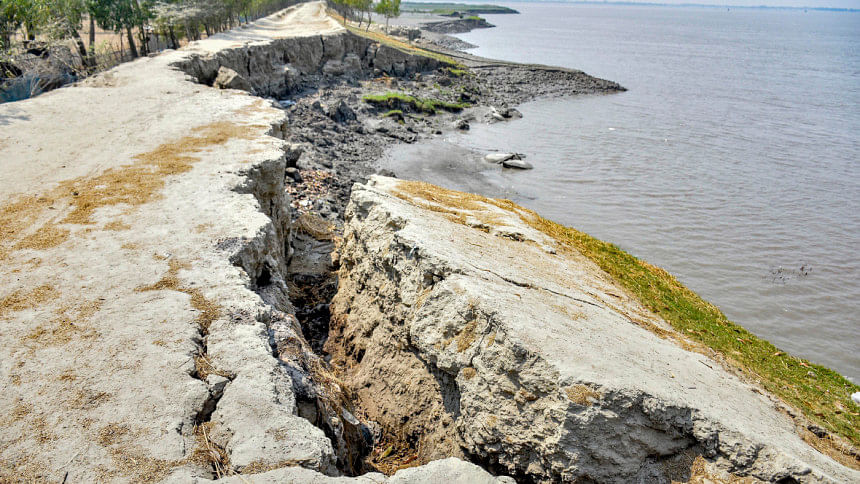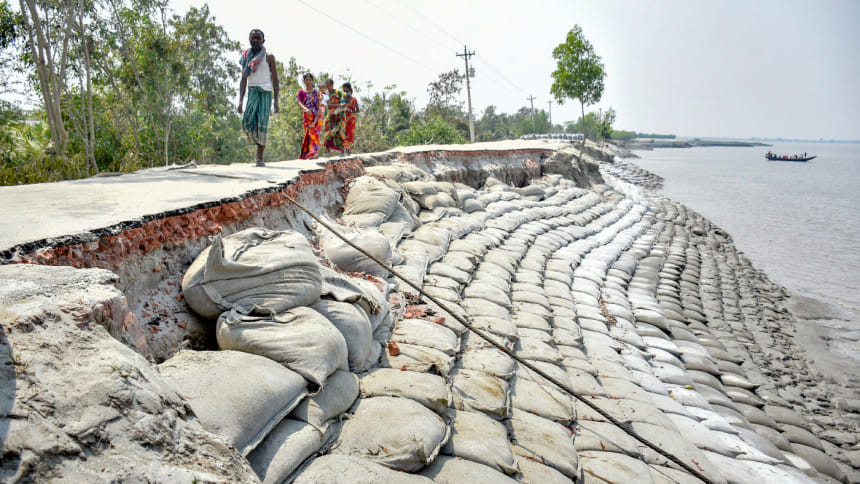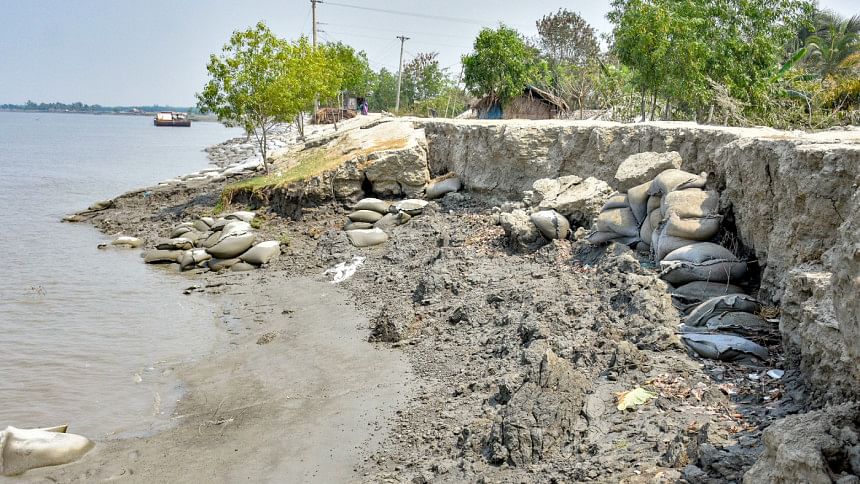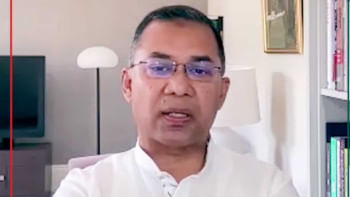Erosion in Khulna’s Dacope Upazila: Of displaced people and lost arable land

Seven of nine unions in the upazila -- including Dacope, Banishanta, and Bajua -- are mostly affected by river erosion. The situation is most dire in Sutarkhali, Kamarkhola, Tildanga, and Pankhali unions. Over one lakh people residing in the aforementioned unions have fallen prey to erosion over the past decade. The erosion and cyclones have forcibly displaced around 20,000 people during this period.
In the 1960s, a series of embankments stretching 153 kilometres were constructed in Khulna's Dacope upazila to protect the region from flooding and erosion.
However, these embankments have remained unrepaired over the last six decades, leading to recurring stories of lost homesteads and arable lands.
According to locals, cyclones Sidr in 2007 and Aila in 2009 caused severe damage to the embankments, further weakening their already vulnerable state.
Additionally, seven rivers -- the Shibsa, Pasur, Dhakai, Bhadra, Manga, Jhapjhapia, and Chunkuri -- flowing through the upazila have suffered due to unplanned and faulty construction of sluice gates.

These actions have further deteriorated the embankments' conditions.
Meanwhile, some locals have resorted to cutting through the embankments to create shrimp enclosures, resulting in the loss of crucial protective barriers and the diversion of water for personal gain.
Presently, the extent of damage is evident, with breaches in at least 30 points of the embankment within a 15km stretch of the overall length.
As a result, seven of nine unions in the upazila -- including Dacope, Banishanta, and Bajua -- are mostly affected by river erosion. The situation is most dire in Sutarkhali, Kamarkhola, Tildanga, and Pankhali unions.
Over one lakh people residing in the aforementioned unions have fallen prey to erosion over the past decade. The erosion and cyclones have forcibly displaced around 20,000 people during this period, said Dacope upazila chairman Monsur Ali Khan.
A recent example would be the Manga erosion, which devoured a stretch of over 1.5km in Pankhali union's Kheyaghat in the last few years.
"The riverbanks have been eroding for the last 10-12 years, but the Water Development Board did not build any sustainable dams to protect us. They only deploy a few geo-bags, which are washed away when the water level rises," said Yasin Sheikh, a resident of the union.

Due to this, many people have been compelled to relocate to safer spots, losing their homesteads and arable lands, he added.
Residents of Joynagar, Hatkhola Gate, Gunari, Kalibari, Nalian, Jaliakhali, Kalabagi, Sutarkhali, and Kaminibasiya areas in Chalna Municipality are also in distress.
As per an evaluation done a few years ago, almost 10,000 bighas of arable land were lost due to erosion in the upazila. Around 20,000 people from across 50 villages have been displaced, said Monsur Ali Khan, chairman of the upazila.
"Thousands are affected by the erosion every year. Building a sustainable dam is the only way to save them," he said.
Around 36 families in Tildanga union's Kaminibasiya village have lost their homesteads to erosion this year, said Jalal Uddin Gazi, the chairman of the union.
The soil quality of the western region is different, and it is important to examine the soil texture before planning dams here, said Prof Sanaul Islam of Soil Science Discipline at Khulna University.
"If the soil is not elastic enough, the newly-constructed embankments will also be washed away when the river swells. The soil has to be feasible for building dams," he added.
According to WDB, Coastal Embankment Development Project, Phase-I (CEIP-I), a Tk 3,280 crore project was initiated in 2012-13 fiscal year to build sustainable embankments in six coastal districts, including Khulna.
Dams stretching around 50km in Dacope upazila's Kamarkhola and Sutarkhali unions and another 50km in Bajua, Dacope, Banishanta, Laudob and Kailashganj unions were supposed to be constructed under this project between July 2016 and December 2022.
Additionally, 36 culverts and sluice gates were constructed, and 17km of canals were also supposed to be reexcavated, spending around Tk 350 crore.
However, the work has not been completed yet.
"The rivers' nature was different when work started back in 2013, as there were no signs of erosion in many of the aforementioned areas. But with time, the course and nature of the rivers changed, and the erosion took on a more deadly face," said Ashraful Alam, executive engineer of WDB Khulna-2.
"The project is almost complete," he added.

 For all latest news, follow The Daily Star's Google News channel.
For all latest news, follow The Daily Star's Google News channel. 



Comments